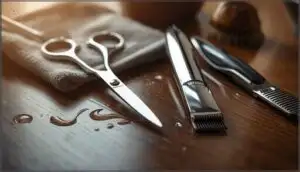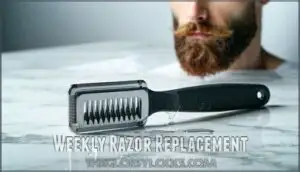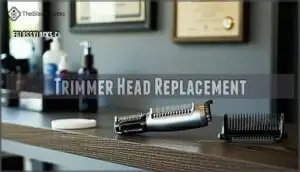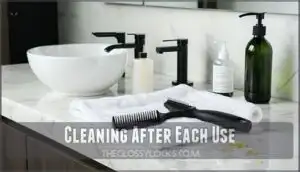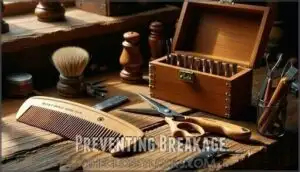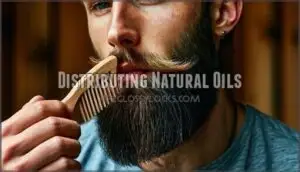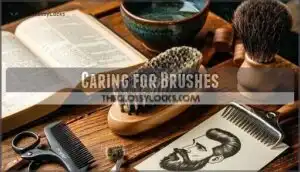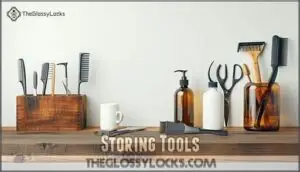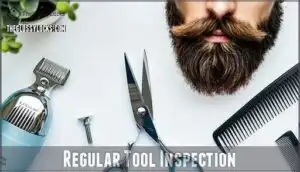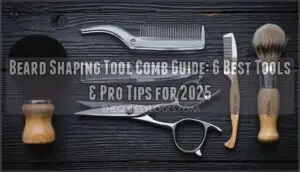This site is supported by our readers. We may earn a commission, at no cost to you, if you purchase through links.
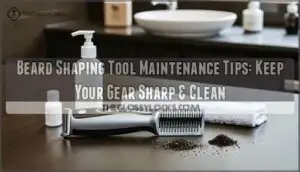
Replace trimmer blades weekly and brush heads monthly to maintain sharp, effective cutting.
Clean combs and brushes thoroughly to remove hair debris and oil residue that can clog bristles.
Store everything in a dry location to prevent rust and bacterial growth.
Weekly inspections catch worn parts before they damage your beard or irritate skin.
Sharp tools mean cleaner lines and healthier facial hair – but there’s more to maximizing your grooming arsenal’s lifespan.
Table Of Contents
Key Takeaways
- Clean your tools after every use – rinse with warm water, scrub with mild soap, and disinfect with 70% isopropyl alcohol to prevent bacteria buildup that can irritate your skin.
- Replace blades and heads regularly – swap trimmer blades weekly and brush heads monthly to maintain sharp, effective cutting that won’t tug or damage your beard.
- Store everything completely dry – keep your tools in a dry, ventilated area to prevent rust and bacterial growth that can compromise their performance and hygiene.
- Inspect your tools weekly – check for dull blades, worn bristles, or damaged components before they affect your grooming results or cause skin irritation.
Cleaning Beard Tools
Proper cleaning keeps your beard tools sharp, hygienic, and effective for years of reliable grooming.
You’ll prevent bacteria buildup and maintain the precision needed for professional-looking results every time you trim.
Warm Water and Mild Soap
Most beard tools need regular cleaning with warm water and mild soap after each use.
This simple cleaning solution removes hair debris, oils, and bacteria that accumulate during grooming sessions.
Choose gentle cleansing products that won’t damage metal surfaces or plastic components.
Proper water temperature guarantees effective sanitizing without warping handles or dulling blades.
Proper care is essential for maintaining the quality and longevity of beard tools, and following these steps ensures they remain in good condition, free from hair debris.
70% Isopropyl Alcohol Disinfectant
When dealing with shared tools or skin nicks, you’ll need stronger antiseptic uses than soap alone.
Alcohol concentration at 70% provides maximum germ killing power for your tool maintenance guide. To guarantee thorough cleaning, consider the benefits of alcohol cleaning.
Maximize your cleaning power with 70% isopropyl alcohol—the gold standard for eliminating germs on beard tools.
- Disinfectant properties: Eliminates bacteria and viruses effectively
- Sanitizing solutions: Perfect for combs, trimmers, and razors
- Brush cleaners: Safe alternative to harsh chemicals
- Rust prevention: Alcohol evaporates quickly, reducing moisture damage
- Tool cleaning tips: Apply with cotton pad, let air dry
Brushing Free of Hair and Debris
Hair and debris build up quickly on grooming tools, reducing their performance and creating hygiene issues.
You’ll want to brush your tools before and after each use to maintain peak tool effectiveness. This simple habit prevents clogged trimmer blades and keeps your beard brush bristles working properly for ideal detangling.
| Tool Type | Brush Material | Cleaning Frequency | Debris Impact |
|---|---|---|---|
| Boar bristle brush | Natural bristles | After each use | Reduces oil distribution |
| Beard cleaning comb | Plastic/metal | Before/after use | Affects detangling ability |
| Electric trimmer | Metal blades | Daily maintenance | Clogs cutting mechanism |
| Brush cleaners | Synthetic bristles | Weekly deep clean | Maintains bristle type integrity |
Sanitizing Trimmers
Your trimmer’s cutting blades collect bacteria, dead skin, and hair particles that can cause infections if not properly sanitized.
Clean trimmers prevent infections from bacteria lurking on dirty blades.
Regular cleaning with disinfectant keeps your tools hygienic and extends their lifespan substantially.
Weekly Razor Replacement
Replace your razor blades every 5-10 shaves to maintain razor sharpness and cutting efficiency.
Daily shavers need weekly blade replacement, while occasional users can extend this to 2-3 weeks.
Sharp blades require less pressure, reducing nicks and razor burn during tool maintenance.
Handle maintenance includes proper cleaning after each shave.
Fresh blades guarantee safety precautions while shaving with the grain for superior results.
For superior grooming results, consider using a replacement blade to maintain your gear.
Trimmer Head Replacement
Every five replacements signal it’s time for trimmer head replacement to maintain peak performance.
Dull blades create tugging sensations and require multiple passes for even cuts. Watch for rust spots, excessive noise, or vibration during beard trimmer maintenance.
Tool replacement becomes essential when sharpness checks reveal compromised effectiveness, ensuring your trimmer upkeep delivers consistently smooth results.
Regular string trimmer maintenance is vital for superior performance and longevity of the tool.
Cleaning After Each Use
Proper daily sanitizing keeps your beard shaping tool performing at peak levels.
After each trimming session, you’ll want to establish consistent tool hygiene habits that prevent bacteria buildup and extend your equipment’s lifespan.
Here’s your post-use cleaning routine:
- Rinse with warm water – Remove loose hair and debris immediately after trimming
- Apply gentle cleansers – Use mild soap or specialized cleaning solutions on blades and combs
- Disinfect contact surfaces – Wipe down handles and guards with sanitizing solution
- Air dry completely – Store tools only after they’re thoroughly dried to prevent rust
Regular maintenance of your beard trimming scissors and other equipment isn’t just about cleanliness—it’s about preserving the precision that gives you control over your grooming results.
Clean tools cut better, last longer, and keep your skin healthy.
Following a routine that includes clean razor practices can substantially improve the overall performance and longevity of your grooming tools.
Maintaining Combs
Your beard comb works hard every day, detangling knots and styling your facial hair into shape.
Proper maintenance keeps it functioning effectively while preventing bacteria buildup that could irritate your skin.
Detangling and Styling
Your comb becomes the conductor’s baton for beard detangling and styling mastery.
Work through damp facial hair using gentle downward strokes, starting from roots to tips.
This beard combing technique prevents snags while distributing natural oils evenly.
For styling tips, comb hair in your desired direction after applying beard oil.
Effective hair detangling requires patience—rushing creates tangles and potential breakage during your beard brushing routine.
Regular use of a beard comb tool helps maintain healthy beard growth and prevents ingrown hairs.
Preventing Breakage
Anyone can damage their beard with careless combing techniques. Wet hair breaks easier than dry, so you’ll want to wait until your beard’s mostly dry before reaching for that comb.
Here’s your breakage prevention toolkit:
- Gentle Trimming – Use smooth, downward strokes instead of aggressive pulling
- Tool Handling – Choose wooden combs over plastic for reduced static and Hair Care
- Damaged Tools check – Replace cracked or bent teeth immediately for Beard Protection
Quality beard shaping tool maintenance prevents unnecessary breakage and keeps your facial hair looking sharp. Regular use of beard comb tools is essential for maintaining a healthy beard.
Distributing Natural Oils
Your beard comb acts as nature’s distribution system, channeling natural sebum from your skin throughout each whisker.
When you work the comb through your beard, you’re spreading this protective oil that keeps hair nourished and prevents dryness.
This oil distribution process enhances your beard care routine by naturally moisturizing without additional beard oil products, using natural sebum to keep your beard nourished.
Caring for Brushes
Your beard brush needs regular cleaning to maintain its effectiveness and prevent bacterial buildup that can irritate your skin.
Proper care extends the life of boar bristle brushes while ensuring they continue distributing natural oils and exfoliating dead skin cells.
Boar’s Hair Benefits
Your boar bristle brush isn’t just another grooming gadget—it’s your secret weapon for superior beard care.
This natural tool mimics your hair’s texture perfectly, creating ideal oil distribution that synthetic brushes can’t match.
- Enhanced beard shine through natural sebum spreading
- Improved hair growth environment via gentle scalp stimulation
- Superior oil distribution compared to synthetic alternatives
- Better skin health through natural exfoliation properties
- Professional beard shaping tool performance for styling control
To maintain its effectiveness, understanding beard brush materials is vital for making informed decisions about your grooming routine.
Exfoliating Skin
Your boar’s hair brush becomes your skin’s best ally, working beneath the surface to remove dead skin cells and unclog pores.
This gentle exfoliation process stimulates blood flow while clearing away debris that can lead to irritation.
Regular brushing creates a natural facial massage that promotes healthier skin beneath your beard, setting the foundation for ideal beard skincare routine maintenance, which is crucial for a healthier skin.
Preventing Beard Dandruff
Clean brushes become your secret weapon against the flaky enemy lurking beneath your whiskers.
Regular maintenance fights dandruff causes by removing buildup that feeds harmful microbes:
- Beard Exfoliation – Daily brushing removes dead skin cells and debris
- Scalp Massage – Gentle strokes boost circulation around hair follicles
- Beard Oils distribution – Clean bristles spread moisturizing products evenly
- Bacteria prevention – Sanitized tools stop microbial growth
- Enhanced beard care tips – Proper maintenance maximizes your beard shampoo and beard moisturizer effectiveness
Storing Tools
Proper storage keeps your beard tools in top condition and extends their useful life.
Store all tools completely dry in a clean, ventilated area to prevent rust, bacteria growth, and premature wear.
Dry Storage
Store your beard shaping tools in dry cabinets or storage boxes to prevent rust and corrosion.
Humidity control is essential for maintaining tool sharpness and functionality.
Air tight containers work perfectly for smaller items like scissors and combs.
Avoid bathroom storage where moisture wreaks havoc on metal components.
Proper tool storage extends your grooming arsenal’s lifespan substantially.
Using a dry tool cabinet can help maintain your tools’ condition over time.
Preventing Bacteria Buildup
Moisture creates the perfect breeding ground for harmful microorganisms on your beard shaping tools.
You’ll want to thoroughly dry each tool after cleaning, using a towel first before air-drying completely.
Proper bacteria control through effective sanitizing methods and sterilization techniques keeps your grooming tool maintenance routine hygienic and your beard healthy.
Tool Longevity
Proper storage substantially extends your tools’ lifespan and maintains their performance.
Here are four key storage solutions for maximum tool durability:
- Handle Care – Store tools with wooden or plastic handles away from direct sunlight to prevent cracking
- Metal Maintenance – Keep metal components in low-humidity environments for effective rust prevention
- Tool Storage – Use dedicated compartments or cases to prevent blade damage and maintain sharpness
- Tool Sharpening Guide – Regular maintenance schedules preserve cutting effectiveness and extend replacement intervals
These storage solutions, when implemented correctly, can significantly improve the overall durability and performance of your tools.
Regular Tool Inspection
You’ll need to check your grooming tools regularly to catch problems before they affect your beard’s appearance.
Dull blades, loose screws, or worn bristles can turn a simple trim into a patchy disaster.
Checking for Damage
Regular inspection reveals potential problems before they derail your grooming routine.
Check trimmer blades for nicks, chips, or dullness that compromise cutting precision.
Examine handles for cracks or loose screws that affect grip and control.
Look for rust prevention opportunities on metal components, especially after exposure to moisture.
Inspect combs for broken teeth and brushes for worn bristles that reduce effectiveness.
Replacing Worn-Out Tools
When damage appears, swift tool replacement prevents grooming disasters and skin irritation.
Don’t let worn-out gear sabotage your beard game—replacing compromised tools maintains your grooming standards and protects your investment in a polished appearance.
Key replacement indicators:
- Blade maintenance: Replace razor blades every 5-7 shaves when dullness causes pulling or uneven cuts
- Handle care: Discard tools with cracks or chips that harbor bacteria and compromise sanitation
- Rust prevention: Immediately replace any metal components showing rust, nicks, or deformation regardless of recent cleaning
Ensuring Sharpness and Effectiveness
Sharpness separates professional results from amateur struggles in your beard shaping tool kit.
Test your beard trimming scissors by cutting paper—dull scissors will tear instead of slice cleanly.
Check blade alignment on precision shaping tools monthly, as misaligned edges reduce cutting efficiency dramatically.
Sharp blade care involves gentle cleaning and proper storage.
Tool handle maintenance guarantees steady control during detailed work.
When edge refurbishment becomes necessary, invest in professional sharpening or replacement for peak tool care performance, ensuring sharp blades, proper storage, gentle cleaning, and steady control.
Frequently Asked Questions (FAQs)
What is the rule 5 for beards?
Like knights of old wielding their trusty swords, you must keep your beard trimming tools clean and sharp.
There isn’t a specific "rule 5" for beards, but maintaining your tools properly guarantees they’ll serve you well and keep your facial hair looking precise.
How often should trimmer blades be oiled?
You’ll want to oil your trimmer blades after every few uses or weekly with regular maintenance.
A drop or two keeps them sharp and prevents rust, ensuring smooth cuts every time.
Can beard tools be shared safely between people?
Sharing beard tools is like passing around a razor blade—proceed with extreme caution. You shouldn’t share tools without proper disinfection using 70% isopropyl alcohol, especially after skin contact or nicks.
What temperature water damages electric trimmer components?
Hot water above 140°F can damage your trimmer’s motor, battery, and plastic components.
You’ll want to stick with warm water when cleaning—it’s effective without risking expensive repairs to your grooming gear.
How do you remove rust from scissors?
Rust removal requires gentle abrasion and chemical treatment.
You’ll soak scissors in white vinegar for several hours, then scrub with fine steel wool or baking soda paste.
Rinse thoroughly and oil immediately afterward, this step is crucial for preserving the scissors.
Should beard combs be replaced after illness?
You don’t need to replace beard combs after routine illnesses like colds.
Simply disinfect them with 70% isopropyl alcohol, which kills germs effectively.
This sanitizes your tools without unnecessary waste or expense.
Conclusion
Ironically, neglecting your beard shaping tool maintenance tips will turn your precision grooming arsenal into dull, bacteria-infested instruments that damage the very facial hair you’re trying to perfect.
You’ve invested in quality tools – now protect that investment with consistent cleaning, timely replacements, and proper storage.
Sharp blades and clean surfaces aren’t luxuries; they’re necessities for healthy beard growth and professional-looking results.
Your future self will thank you.
- https://www.healthline.com/health/beauty-skin-care/beard-maintenance
- https://thebeardclub.com/blogs/beard-culture/how-to-clean-beard-trimmer
- https://www.viningsbarber.com/blog/beard-maintenance
- https://www.menshealth.com/grooming/a64162693/how-to-maintain-your-beard-trimmer/
- https://wahlusa.com/expert-advice/beard-mustache-trimming/priming-and-trimming-4-ways-maintain-your-trimmer

